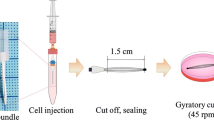Summary
With a view to initiating clinical trials, cell morphology and function for a newly developed artificial liver support system employing highly functional human liver cell line, FLC-7, cultured in a radial flow bioreactor were compared to cells grown in a conventional monolayer culture.
The radial flow bioreactor consists of a vertically extended cylindrical matrix comprised of porous glass bead microcarriers through which liquid medium flows from the periphery in toward the central axis generating a beneficial concentration gradient of oxygen and nutrients, while preventing excessive shear stresses or buildup of waste products. The three-dimensional culture system supports high-density (1.1 × 108 cells/ml-matrix), large scale cultures (4.4 × 1010 cells/400 ml-bioreactor) with long-term viability. Scanning and transmission electron microscopy (SEM and TEM) revealed that cells cultured in a monolayer system were flattened and extended with numerous cytoplasmic projections. Cells in the three-dimensional culture were spherical and covered with microvillilike processes resembling liver cells in vivo. The cells were solidly attached on the surfaces and within the pores of the microcarriers in highly dense colonies. The spherical cells remained in close contact with adjacent cells, while circulation of liquid medium flowed freely through spaces between cells. FLC-7 cells produced albumin at a rate of 6.41 µg/24 h/106 cells. Alpha-fetoprotein (AFP) production dropped nearly threefold in comparison to monolayer cultures. Results demonstrated that the new artificial liver support systems (ALSS) provides a superior three-dimensional culture environment that allows cells to perform at naturally functioning levels.
Similar content being viewed by others
References
Abu-Elmagd, K. M.; Malinchoc, M.; Dickson, E. R., et al. Efficacy of hepatic transplantation in patients with primary sclerosing cholangitis. Surgery 177:335–344; 1993.
Bader, A.; Rinkes, I. H. B.; Closs, E. I. A stable long-term hepatocyte culture system for studies of physiologic processes: cytokine stimulation of the acute phase response in rat and human hepatocytes. Biotechnol. Prog. 8:219–225; 1992.
Fujise, K.; Nagamori, S.; Hasumura, S. Integration of hepatitis B virus DNA into cells of six established human hepatocellular carcinoma cell lines. Hepato-gastroenterology 5:439–532; 1990.
Gerlach, J. C.; Kloppel, K.; Muller, C., et al. Hepatocyte aggregate culture technique for bioreactors in hybrid liver support systems. Intern. J. Artif. Organs 16:843–846; 1993.
Greif, F.; Bronsther, O. L.; Thiel, D. H. V., et al. The incidence, timing, and management of biliary tract complications after orthotopic liver transplantation. Ann. Surg. 219:40–45; 1994.
Homma, S.; Nagamori, S.; Fujise, K., et al. Establishment and characterization of a human hepatocellular carcinoma cell line JHH-7 producing alpha-fetoprotein and carcinoembryonic antigen—changes of secretion of AFP and CEA from JHH-7 cells after heat treatment. Hum. Cell 3:152–157; 1990.
Li, A. P.; Barker, G.; Beck, D., et al. Culturing of primary hepatocytes as entrapped aggregates in a packed bed bioreactor: a potential bioartificial liver. In Vitro Cell. Dev. Biol. 29:249–254; 1993.
Matsushima, H.; Koide, N.; Asano, K., et al. Possible applicability of mixed cells-spheroid as a bioreactor of a hybrid artificial liver. Jpn. J. Artif. Organs 19:848–851; 1990.
Minamoto, Y.; Ogawa, K.; Abe, H., et al. Development of a serum-free and heat-sterilizable medium and continuous high-density cell culture. Cytotechnology 9:35–51; 1991.
Mizutani, S. Bioreactor for animal cells. Bioscience & Ind. (Japan) 48:337; 1990.
Mizutani, S. Radial flow bioreactor. Soshikibaiyou (Japanese) 18:249–254; 1992.
Neuzil, D. F.; Rozga, J.; Moscini, A. D., et al. Use of a novel bioartificial liver in a patient with acute liver insufficiency. Surgery 113:340–342; 1993.
Nyberg, S. L.; Payne, W. D.; Amiot, B., et al. Demonstration of biochemical function by extracorporeal xenohepatocytes in a anhepatic animal model. Transplant. Proc. 25:1944–1945; 1993a.
Nyberg, S. L.; Remmel, R. P.; Mann, H. J., et al. Primary hepatocytes outperform HepG2 cells as the source of biotransformation functions in a bioartificial liver. Ann. Surg. 220:59–67; 1994.
Nyberg, S. L.; Shirabe, K.; Peshwa, M. V., et al. Extracorporeal application of a gel-entrapment, bioartificial liver: demonstration of drug metabolism and other biochemical functions. Cell Transplant. 2:441–452; 1993b.
Page, E. B. L.; Rozga, J.; Rosenthal, P., et al. A bioartificial liver used as a bridge to liver transplantation in a 10-year-old-boy. Am. J. Critical Care 3:224–227; 1994.
Rozga, J.; Podesta, L.; Page, E. L., et al. Control-of cerebral oedema by total hepatectomy and extracorporeal liver support in fulminant hepatic failure. Lancet 342:898–899; 1993.
Sussman, N. L.; Chong, M. G.; Koussayer, T., et al. Reversal of fulminant hepatic failure using an extracorporeal liver assist device. Hepatology 16:60–65; 1992.
Sussman, N. L.; Finegold, M. J.; Barish, J. P., et al. A case of syncytical giant-cell hepatitis treated with an extracorporeal liver assist device. Am. J. Gastroenterol. 89:1077–1082; 1994.
Sussman, N. L.; Kelly, J. H. Improved liver function following treatment with an extracorporeal liver assist device. Artif. Organs 17:27–30; 1993.
Tanabe, T.; Koide, N.; Harutoku, M., et al. Effects of liver biomatrix on cell growth. Jpn. J. Artif. Organs 15:1433–1437; 1986.
Thiel, D. H. V.; Carr, B.; Iwatsuki, S., et al. The 11-year Pittsburgh experience with liver transplantation for hepatocellular carcinoma. J. Surg. Oncol. Suppl. 3:78–82; 1993.
Tobe, S.; Takei, Y.; Kugumiya, Y., et al. Formation mechanism and differential functionality of multilayer hepatocyte-aggregation on artificial biomatrix. Jpn. J. Artif. Organs 20:150–155; 1991.
Yoshida, H.; Mizutani, S.; Ikenaga, H. Continuous production of erythropoietin using a radial flow bioreactor. In: Sasaki, R., ed. Animal cell culture and production of biologicals—Proceedings of the Third Annual Meeting of the Japanese Assocaition for Animal Cell Technology. Dordrecht, Netherlands: Kluwer Academic Publishers; 1991:329–334.
Yoshida, H.; Mizutani, S.; Ikenaga, H. Production of monoclonal antibodies with a radial-flow bioreactor. In: Kaminogawa, S., ed. Animal cell technology. Vol. 5. Dordrecht, Netherlands: Kluwer Academic Publishers; 1993:347–353.
Author information
Authors and Affiliations
Rights and permissions
About this article
Cite this article
Kawada, M., Nagamori, S., Aizaki, H. et al. Massive culture of human liver cancer cells in a newly developed radial flow bioreactor system: Ultrafine structure of functionally enhanced hepatocarcinoma cell lines. In Vitro Cell.Dev.Biol.-Animal 34, 109–115 (1998). https://doi.org/10.1007/s11626-998-0092-z
Received:
Accepted:
Issue Date:
DOI: https://doi.org/10.1007/s11626-998-0092-z




